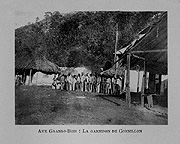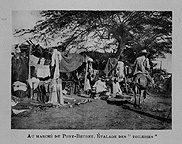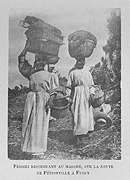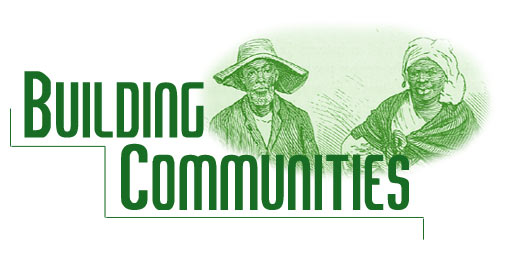
The
freed slaves in Haiti created a system of family
life and labor that combined elements of their African past with elements
of their colonial present. While
the Caribbean can be represented as an end or as a beginning,
the example of the Haitians, with their new language and new labor
practices, give evidence for the argument that what was created by
the former slaves was neither a transplantation of Africa nor a bastardized sense
of the European. Instead, it
was something new.
The
observations of Eugène Aubin,
a French traveler, recorded around the turn of the century mark the
double identity brought about by abolition.
The book’s title—En Haïti; planteurs
d’autrefois, nègres
d’aujourd’hui
[2]
—suggests the contrast: these people were planters,
slaves of before, and today they are forming an identity as free blacks.
Part of this identity involves a new language that, as Aubin
notes, cannot be directly linked to specific African tongues. The naming of the landscape is particularly
significant because it is symbolic of claiming the land. This was now their land. Though some African idioms were lost, some isolated
words appear in creole.
[3]
Geographical nomenclature is part of the process
of forming a national consciousness involves claiming the land, and
this is done in part through naming of the land.
[4]
Working
with the land is another important part of this process. Coumbites were units
of cooperative labor, a system based on a system of give and take. While there were others, such as the more regular
société, coumbites
 were
unique in that they could be organized for any kind of labor: for
a harvest, to build a hut, and for women to do housework. Harold Courlander
suggests that the word comes from the Spanish convide
or convite, “to invite”. There are several kinds of coumbites. Songs performed
during work aroused unity and leadership, and workers were rewarded
with a meal at the end of the coumbite.
[5]
In Jacques Roumain’s
novel Gouverneurs de la rosée
[6]
, which is considered a Haitian classic, Manuel
returns to his village after a ten-year absence and finds it in a
state of upheaval: families are fighting and a drought threatens the
harvest. Only by people working
together can the water be located and brought to the village. The people in the community elevate Manuel to
the status of the coumbite leader. Reverence inspires solidarity, and with the
return of water, the villagers vow to work together once more. were
unique in that they could be organized for any kind of labor: for
a harvest, to build a hut, and for women to do housework. Harold Courlander
suggests that the word comes from the Spanish convide
or convite, “to invite”. There are several kinds of coumbites. Songs performed
during work aroused unity and leadership, and workers were rewarded
with a meal at the end of the coumbite.
[5]
In Jacques Roumain’s
novel Gouverneurs de la rosée
[6]
, which is considered a Haitian classic, Manuel
returns to his village after a ten-year absence and finds it in a
state of upheaval: families are fighting and a drought threatens the
harvest. Only by people working
together can the water be located and brought to the village. The people in the community elevate Manuel to
the status of the coumbite leader. Reverence inspires solidarity, and with the
return of water, the villagers vow to work together once more.
Melville
Herskovits argues that the coumbite
is entirely African.
[7]
Harold Courlander
notes that the mechanics of the work, including the particular use
of the hoe and the use of music to help along the workers, are West
African in origin. Indeed,
Courlander states, “The coumbite
is the legitimate descendant of. . .West African cooperative systems.”
This is not to say that the coumbites
and other Haitian work habits were a transplantation of Africa. Rather, in forming communities in post-emancipation,
African heritage played an important role, but the new language, for
example, is an indication that this was not simply Africa revisited.
Representations
of the plantation workers’ lives in the late nineteenth century characterize
the communities as Edenic, happy places;
Roumain uses the memory of a past where the community was
united for an important message in his novel.
Did a paradisiacal world, in spite of poverty, really exist? Joan Dayan argues
that it probably did not.
[8]
Dayan refers to the
writers Roumain and Chauvet,
but what did the plantation workers think?
We have little to go on. Perhaps
the views of Paul Dhormys are romanticized,
but his perception of the Haitians as of nature, of the land, is significant. Haitian indolence may have been an issue, as
it is mentioned frequently in post-emancipation writings, but what
do the coumbites represent, then?
Dhormys criticizes the Haitians as
uncivilized and free in  their
lack of metropolitan civilized norms, but this is of course evidence
of their forming an identity; naturally, how they and their ancestors
lived in Africa play a role in how they live in Haiti. The coumbites did
provide a means not only for effective labor during the harvest, but
also for the fostering of a sense of community.
What we would call art and music were integral parts of their
daily life, as Herskovits notes the importance
of communication through the songs and of the transmission and exchange
of gossip. their
lack of metropolitan civilized norms, but this is of course evidence
of their forming an identity; naturally, how they and their ancestors
lived in Africa play a role in how they live in Haiti. The coumbites did
provide a means not only for effective labor during the harvest, but
also for the fostering of a sense of community.
What we would call art and music were integral parts of their
daily life, as Herskovits notes the importance
of communication through the songs and of the transmission and exchange
of gossip.
With
freedom comes the problem of regrouping, and Samuel Hazard suggests
that it would be best if the United States were to annex Haiti. “Do they not know that the men of the island
exist upon the industry of the women, who are really the only laborers;
and that, furthermore, at least two-thirds of the population do not
speak any language recognised by the civilised
world; that there is not a town on the island not remaining in ruins
more or less caused by their revolutions?”
Citing Ardouin, Hazard notes the
lazy youth, the abundance of the “natural union” without marriage,
leading to “irregular and irresponsible families and ties” (Ardouin).
[9]
Paul
Dhormoys notes what he regards as the simplicity
of the needs of blacks, and he depicts the richness of the land full
of fruit, the river full of fish, tobacco as common as a weed, and
as for clothes: “. . .à quoi bon s’en inquiéter?
est-il un jour de l’année où ils ne
soient, pour l’enfant
de la nature, moins une
utilité qu’une gêne?” (“what good is worrying? Is there a day of the year where they are not,
for the child of nature, less a useful thing than an annoyance?”) Dhormoys argues that
Haitians do not have the same concept of work that Europeans have,
that they do not agree that without work “. . .il
n’y a plus ni société,
ni civilisation,
ni progrès, ils
vous répondront
que, ne manquant
de rien, ils se
soucient assez peu du progrès de la civilisation, de la société, et.
. .ils vous prieront poliment de vous ôter de leur
soleil.” (“. . .there is no longer society,
or civilization, or progress, they will respond that, not lacking
anything, they worry rather little about the progress of civilization,
of society, and they would ask you politely to move away from their
sun” (63-64). Dhormoys finds this
kind of life positive, where one is born free of the needs of a civilized
people, “n’ayant aucun
de nos besoins de civilisés, peuvent laisser couler la vie sans regrets
de la veille ni
soucis du lendemain!” (. . .not
having any of our civilized needs, can let life flow without regrets
of the day before or worries of tomorrow!”.
[10]
This view of Haitians as a simplistic people
perpetuates the myth of the happy brute.
By
contrast, Eugène Aubin’s
depiction of Haiti is positive and respectful.
He includes in great detail the words used; this personal account
illustrates what a coumbite was like.
Particularly notable about this description is that Aubin
quotes five coumbite songs in the original creole,
and it is the French translations that appear in parentheses. His description agrees with the later authoritative
writings of Herskovits and Courlander. What
follows is an extended quotation from Aubin’s
description of a coumbite.
“On
a slope, at the side of the road, a dozen cultivaters
work in a coumbite.
A planté-patate is needed, and the
master of the fields called to this end a dozen of his neighbors. The coumbite is a
community of organized labor, as widespread by the small properties
of the mountains as among the sharecroppers of the plain. The communal effort is made more quickly and
more gaily one comes to cultivate the goods of the next who, in turn,
will cultivate yours. The coumbite
is a type of agricultural association, where the Negro finds a new
occasion to sing and drink. There
are different types. If a short
task is needed that will be finished in the first hours of the morning,
it is a simple douvant-jou; or as well in the afternoon, from two to five,
a diné-manchette: the grand coumbite
comprises a prolonged work that lasts until noon. The master of the field, who becomes, for this
circumstance, the master of the coumbite,
has no other affair but to feed his workers; he oversees, in a corner,
the cauldron where peas and rice are cooking, and rushes, at each
requisition, with a bottle of tafia.. .
.They are there, held tightly one against the other and striking the
earth with their hoe; one of the two, knocking his manchette
with a piece of iron, marks this cadence and repeats indefinitely
the traditional song, which must be reprised by the ensemble
[11]
:
Ago!
houe démanchée
Ti gaçon, manché li ban moin!
[“Let’s
go! The handle is removed from the hoe,
Little boys, put it back on for me!”]
Mealtime
means a special call:
Tendé
ça, moin dit ou
Vent’ m’apé mangnien moin!
[“Listen,
I say to you
The stomach works me!”]
It finishes with an gesture of gratitude:
Vive
le chef la commune,
Qui baille tranquillité!
Vive chez section,
Qui pèmette nous dangoïé!
Vive chef coumbite!
["Long
live the commander, who gives us security!
Long live the master, who allows us to frolic!
Long live the master of the coumbite!"]
If
this last one has done things badly, it is the moment to make him
feel:
Moin pas pr'allé encò
Nan mangé cilà-là
Nous pas pé mouri pour tête moure encò!
["We
will go no longer in this dîné; we will die no longer
for anyone!"]
One
the work is finished, the Negroes separate from each other singing
the Mazonne:
Gé
veillé cò!
N'a oué ça;
N'apr' allé la cäy!
["The
eyes watch over the body; we will see that; we are going home!"]
Importantly,
Aubin quotes the coumbite
songs. This is particularly
significant because he gives the Haitians a voice—their voice.
 Women
were particularly important in getting work done. Aubin notes that it
is the women who do the coming and going.
[12]
Courlander notes “a
clear-cut and equitable division of labor between the sexes which
was particularly suited to the agrarian life.
The pattern of work sharing seems to have been misunderstood
by nineteenth-century chroniclers, many of whom complained that the
Haitian male napped in the shade while the women performed all the
labor”.
[13] Women
were particularly important in getting work done. Aubin notes that it
is the women who do the coming and going.
[12]
Courlander notes “a
clear-cut and equitable division of labor between the sexes which
was particularly suited to the agrarian life.
The pattern of work sharing seems to have been misunderstood
by nineteenth-century chroniclers, many of whom complained that the
Haitian male napped in the shade while the women performed all the
labor”.
[13]
In
my research I was unable to find writing done by plantation workers
because There is no real slave or former slave narrative in French. What I did find in their voice was their songs.
These coumbite songs, performed to
arouse a congenial working atmosphere, represent the creativity that
was born in the New World.
Bibliography
Primary:
Aubin, Eugène. En Haïti; planteurs d’autrefois, nègres d’aujourd’hui. Paris, A. Colin, 1910.
Dhormoys, Paul. Une visite chez Soulouque : souvenirs
d'un voyage dans l'ile
d'Haiti. Paris: Librairie
Nouvelle, 1859.
Hazard, Samuel. Santo Domingo, past and present, with
a glance at Hayti. New York, Harper & Brothers,
1873.
Herskovits, Melville J. Life in a Haitian Valley. (1937). Reprint:
Anchor, 1971.
Secondary:
Courlander, Harold. The drum and the hoe; life and lore of the Haitian
people. Berkeley: University of California Press, 1973.
Dayan, Joan. Haiti, history, and the gods.
Berkeley: U of California P, 1995.
[1]
“Long live the coumbite leader!”
[2]
Eugene Aubin, En Haïti; planteurs d’autrefois, nègres d’aujourd’hui [In Haiti; planters of before, Negroes of today],
(Paris, 1910).
[4]
Aubin cites these examples of creole
words for the landscape, with French definitions in parentheses:
“. . . les mornes (montagnes), les pitons
(pics), les platons (plateaux), les coupes (cols), les fonds ou
trous
(vallées), les arses ou aculs (fond d’un baie), les anses, les caps,
les côtes de fer (rivages de rocher), les tapions (falaises), les lagons (lagures). . .”: Aubin, 72.
[5]
For a description of coumbites
in more detail, see Harold Courlander,
The Drum and the Hoe; Life and Lore of the Haitian
People, (Berkeley, 1973), 116-120.
[6]
Jacques Roumain, Gouverneurs de la Rosée, Roman
[Masters of the Dew], (Port-au-Prince, 1944.)
[7]
Herskovits, : “In the organization of production and distribution an African
mold, if not full content, predominates. The cooperative work-system, which is so important
in maintaining agricultural production, is directly related to comparable
groupings of West Africa. . .The combite, as an instrument of co-operative
labor and mutual self-help, with its tradition of giving no pecuniary
reward for work done, but of making the feast which comes at the
end of the day’s labor adequate return—all these represent pure
retentions of African practice.
Even more striking is the carry-over in the attitudes which
go with these outer forms—the manner in which the participants look
forward with pleasant anticipation to taking part in combites,
the enjoyment which they derive from their group work, and the verve
with which the work is done are clear expressions of these attitudes. The role of the combite-song in exercising social
control and enforcing conformity to local custom is entirely African,
as is its function in stimulating work by setting a rhythm for it.”
259-60
[8]
Joan Dayan, Haiti, History and the Gods, (Berkeley,
1995), 86-88.
[9]
Samuel Hazard, Santo Domingo, Past and Present,
with a Glance at Hayti, (New York, 1873), 434-36.
[10]
Paul Dhormoys, Une Visite Chez Soulouque: Souvenirs
d'un Voyage dans l'ile
d'Haiti, (Paris, 1859), 62-64,
my italics.
[11]
Aubin, 106-7: “Au sommet, la forêt s’est éclaircie et les caféières ont fait place aux cultures
de vivres.
Sur une
pente, au bord de la route, une douzaine de cultivatuers travaillent en coumbite. Il s’agit d’un planté-patates, et le maître du
champs a convoqué dans
ce but une douzaine
de ses voisins. Le coumbite est un monde d’organisation du travail,
aussi répandu
chez les petits propriétaires
des mornes que
parmi les métayers de la plaine. L’effort en commun se fait plus
vite et plus gaiement on vient cultiver le bien du prochain, qui, à son tour,
cultivera le vôtre. Le coumbite est une sorte
d’association agricole,
où le nègre trouve
une occasion nouvelle de chanter et de
boire. Il en est de différentes espèces. S’agit-il d’une courte besogne qui s’achèvera dans les premières heures du matin, c’est un simple douvant-jou; ou bien dans
l’après-midi, de deux
à cinq, un diné-manchette: le grand
coumbite comporte
un travail prolongé qui dure
jusqu’au midi. Le maître du champ, qui devient, pour
le circonstance, le chef du coumbite,
n’a d’autre
affaire que de nourrir ses travailleurs; il surveille, dans
un coin, le chaudron où
cuisent les pois et riz, et accourt, à chaque réquisition, avec la bouteille de tafia. Quelques-uns piquent les pieds de patates, après que le gros des travailleurs a remué le sol. Ils sont là,
serrés les uns
contre les autres et grattant la terre de leur houe; l’un
deux, frappant
[107] sa manchette d’un morceau de fer, marque la cadence et répète indéfiniment la chanson traditionelle,
qui doit être
reprise par l’ensemble. . .”
|

